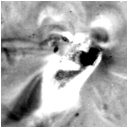
The cusp configuration in soft X-rays - also known as a "helmet streamer" has a very direct significance to people studying the solar corona. Normally its pointy geometry means oppositely directed magnetic fields, a thin current layer to keep them apart, and... MAGNETIC RECONNECTION because the fields have the right orientations to do that. The physics of magnetic reconnection is incalculably important in understanding the behavior of the solar corona, since in the concentric region between the photosphere and the solar wind, the field dominates the forces at work. It is much stronger than gravity or gas pressure, as a rule. Thus we keep our eyes peeled for beautiful cusps, such as the one below accidentally caught just as the Moon was crossing the face of the Sun in a partial eclipse of Feb. 16, 1999:

The tip of the cusp is actually behind the Moon - note its sharp inner edge, which is typical, and the fact that the cusp structure straddles the solar equator, which is quite unusual.
The interesting thing this week - was the occurrence of not one, but two successive cusp features in the same active region. Unlike the case of the imperturbable cusp reported in a science nugget from last month, in this case the cusp created by one flare was grossly perturbed (perhaps destroyed) by a flare the very next day. The images below illustrate the phenomenon:

|

|
The early cusp was replaced, in the same active region, by the later cusp. The difference image shows the hole (black) where it had been. Here then is a case where the flare, an M7 event, seems to have disrupted an adjacent part of the coronal magnetic field - a "restructuring". Click here for a plot of the soft X-ray time history of the flare, with dotted lines showing where the two images above were taken.
Both of these cusps, as is common, followed major flares of the type associated with CMEs - we can't check their occurrence directly this time, though, because the LASCO coronagraphs on SOHO were in the middle of a short break in observations with mirror doors closed to avoid contamination during a thruster firing.
The three panels below show the development of the first of the events, which was remarkably tall and thin (ignore the rectilinear dark saturated areas; these are long exposures to bring out the faint features). The cusp is the feature pointing towards the lower left, and the three panels clearly show that the cuspiness (ie, the non-rounded tip) developed in the late phase of the flare. This cusp, as well as the imperturbable one, really seem flat (planar) although with our two-dimensional view we can't say for sure.

|

|
with the usual light curve displayed below so that one can see where the cusp configuration changed as a function of time. The primary energy release of the flare occurs when the soft X-ray flux increases rapidly (this is what we call "chromospheric evaporation", and it's closely related to the Neupert Effect). Thus if magnetic reconnection explains the flare, the cusp-like shape of the coronal field is a bit of a red herring, it seems.
The points marked with asterisks on the images above show the location of apparent Sun center. Geometry requires that a vertical structure should be stretched out along the radial line to Sun center, and that's what our cusps do approximately. So, are they radial? Or are they tilted (certainly the early cusp looks tilted) but in just such a way as to leave the projection of the line of symmetry just about on the radial to Sun center? We need STEREO to know for sure...
Coronal behavior seems ever more baffling - maybe we are in the wrong business here. The cusp configuration, if a true one, strongly implies that the flare has "opened" some magnetic field lines originating in or near a sunspot region of strong field. Here "opened" means that the field-line goes to infinity as a part of the solar wind.
Stay tuned please, we are working on questions like this...